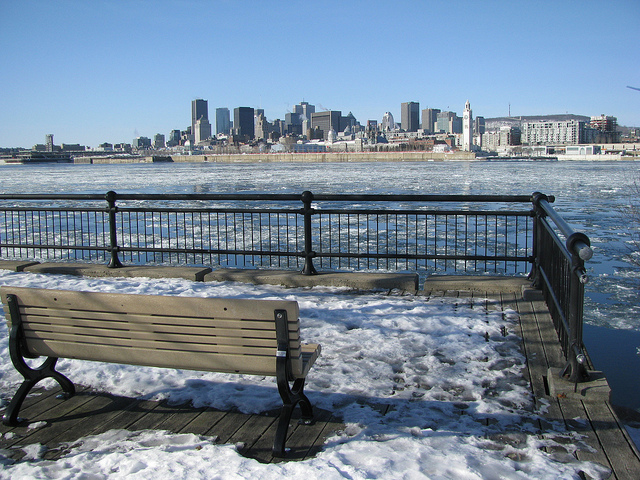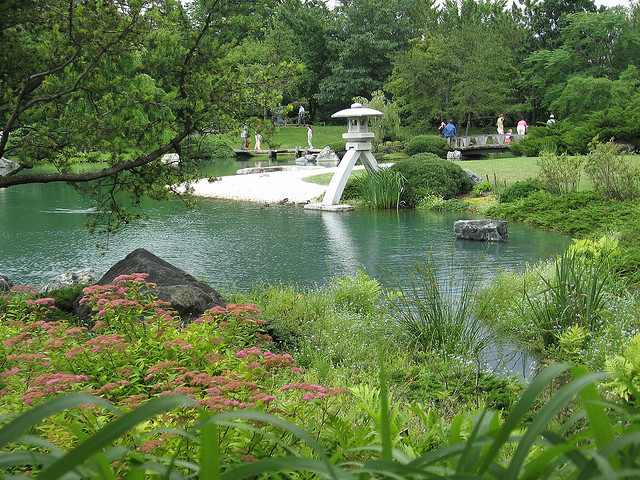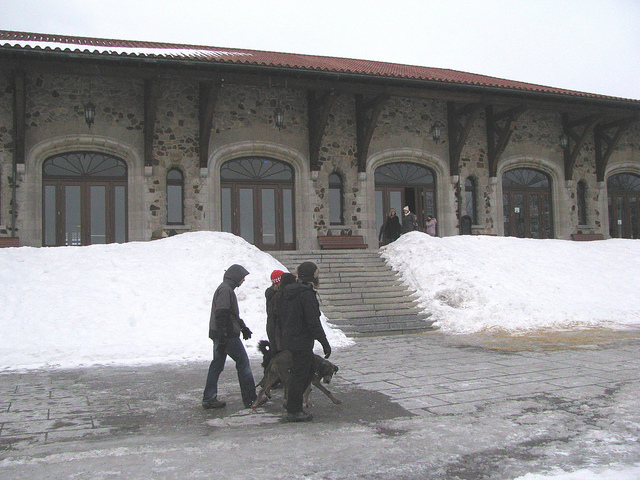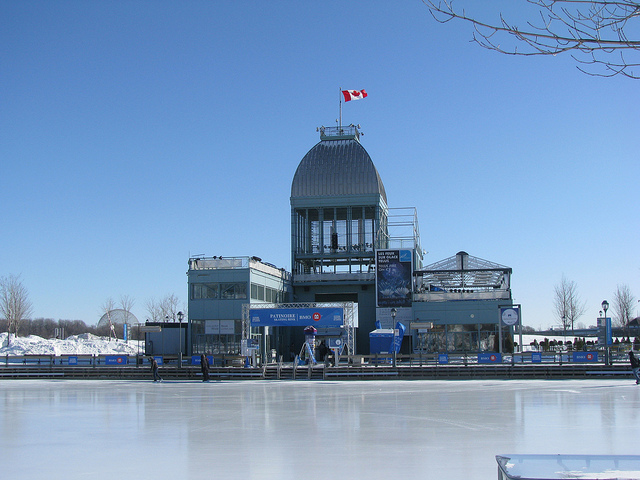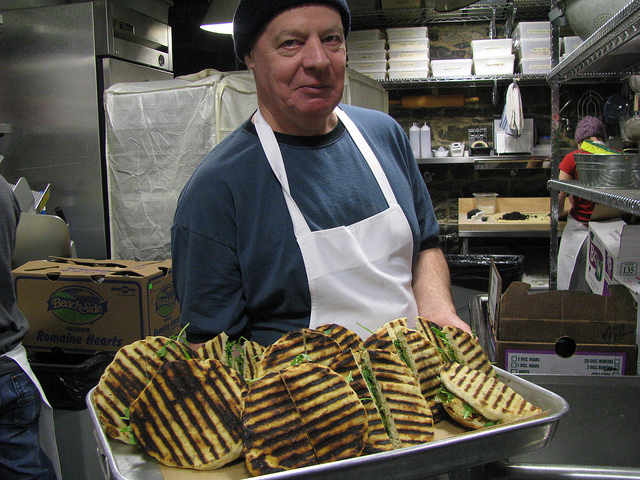Another packed day was in store for Day 3 (Feb 21, 2011) of our Montreal adventure. In the morning, expert tour guide Ronald Poiré from VDM Global met us for a driving tour of the city. A personal guided tour with a local expert is the best way to get to know a city. We left from Old Montreal, went across the Saint Lawrence River to Parc Jean Drapeau , located on two islands inside the river.

This was the location of the Expo 67 World’s Fair that put Montreal on the international map in many ways. Today it is still the site of the Montreal Grand Prix, the Montreal Casino, and the “La Ronde” amusement park. The former U.S. Pavilion, a geodesic dome designed by Buckminster Fuller was turned into today’s Biosphère, a museum to dedicated to the environment. At the western side of the park we got out of the car, braced the chilly wind and enjoyed a phenomenal view across the river towards downtown Montreal and the mountain.
Then we headed a bit south to Habitat 67, a housing complex of interlocking concrete forms that was designed by pioneering architect Moshe Safdie. Past some old grain elevators from the early 20th century who fulfilled a critical role in Montreal’s economic history but who stand abandoned today, facing an uncertain future.

Back on the island of Montreal we headed downtown where got to see a collection of skyscrapers that dominate the skyline. Notably, none of the skyscrapers are allowed to be higher than Mount Royal, so their height is capped at 233 metres. The highest building is the 51 storey 1000 de la Gauchetière, while one of the most iconic buildings is 1 Place Ville-Marie; built in 1962, it is one of the earliest modern skyscrapers in downtown Montreal.
We also stopped on Dorchester Square to have a look at the historic Sun Life Building, a set-back 24 storey high skyscraper completed in 1931. On the other side of Boulevard René-Lévesque is the stunning Cathedral-Basilica of Mary, Queen of the World, the third largest church in Quebec , with a green cupola that is reminiscent of Saint Peter’s Basilica in Rome.
Our next brief stop was at the entrance to the campus of McGill University, one of Canada’s top-ranked and most prestigious universities. It was founded in 1821 by Scottish merchant James McGill and has more than 33,000 undergraduate and postgraduate students. McGill’s sprawling downtown campus covers 79 acres (32 hectares) and features many impressive historic buildings.

We continued our drive past the Golden Mile to Westmount, one of Montreal’s wealthiest residential areas. Roland stopped the car on Summit Circle which allowed us to admire the impressive mansions as well as enjoy a sweeping vista across downtown Montreal and the St. Lawrence River of the south side of Montreal.
Continuing our drive through the leafy streets of Westmount we came down the mountain near St. Joseph’s Oratory, the largest church in all of Canada with the third largest dome in the world. Brother André, known as the “miracle worker of Mount Royal” for his reputed healing power, began construction of a small chapel on this site in 1904; in 1924 the construction of today’s basilica was started and the enormous building was finally completed in 1967. St. Joseph’s Oratory is one of Canada’s most important pilgrimage sites and attracts more than two million visitors and pilgrims every year.
Then we crossed Mount Royal and came down on the east side in the popular Plateau neighbourhood of Montreal. This formerly working class neighbourhood was historically composed of Québécois and Jewish residents. Most notably it was the childhood home of Mordecai Richler who set many of his stories here against the backdrop of the 1950s and 1960s. In the Mile end neighbourhood, which is part of the Plateau-Mont-Royal, Roland took us to Fairmount Bagel, one of this area’s institutions, as we could tell from the long line-up that stretched from inside the store to outside of the building.
Brought to Montreal by its Jewish immigrants, bagels, and in particular, sesame seed bagels, have become a staple of Montreal cuisine. Roland explained that these bagels are boiled in water with a touch of honey and then they are baked on wood-fired ovens. Fairmount Bagels is open 24 hours a day, 365 days a year. Fairmount Bagel goes back to 1919 when Isadore Shlafman came to Canada and opened Montreal’s first bagel bakery. In 1949 he moved from Saint-Lawrence Boulevard to today’s location on Fairmount Street and his grandchildren are still continuing his business.

Not far away we stopped in Montreal’s Little Italy, at a Roman Catholic Church of the Madonna della Difesa, a beautiful church built by Italian immigrants that was consecrated in 1919. The congregation was just filing out as we entered this impressive structure which features a large cupola with numerous frescos. The most well-known wall painting depicts Benito Mussolini and was completed before World War II. In front of the church is a statue that commemorates victims of all wars.
Continuing in Little Italy, we made a stop at the Jean Talon Market, a large farmer’s market that was opened in 1933. About 300 vendors sell anything from fruits and vegetables, to sausages and meat products, fish and cheese, spices and bulk foods. We sat down for a late lunch inside the Boulangerie Première Moison, where I enjoyed a delicious baguette with melted brie and a pear.

Along the way, Roland enlightened us with his insider knowledge of Montreal, which despite its cold winters, provides a great quality of life to its residents. Roland added that Montreal is a relatively compact and very walkable city with a great public transit system. Real estate is more affordable than in many other urban centres and electricity is subsidized by the government.
Our expert explained that Montreal enjoys a stronger connection with Europe and New York City than with Toronto; there has indeed been a long rivalry between these Canadian cities. We touched on the history of Montreal which was shaped by three main groups: the French and Scottish as well as Jewish immigrants. Roland also discussed the Quiet Revolution of the 1960s when traditional power structures and the Roman Catholic Church lost their grip on the population. Many Quebeckers long perceived the church as an oppressive force, and Quebec society became rapidly secular. During the same period Quebec experienced unbridled economic and social development which created a more egalitarian society and also led to a rise in Quebec nationalism. Today, Quebec is a proud region of Canada with a unique culture that attracted 26 million foreign tourists.
Our driving tour had come to an end and we had thoroughly enjoyed our insider introduction to Montreal provided by our local expert Roland Poiré. Now it was time to sample another unique Montreal experience: circus arts at La Tohu.

